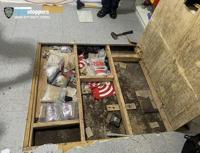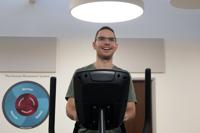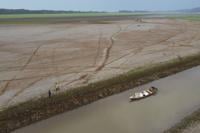SUKHBAATAR, Mongolia (AP) — The half-crescent moon glowed in the predawn Mongolia sky as Agvaantogtokh and his family began preparing for yet another big move with their animals.
On horseback, he rode to a well with nearly a thousand sheep and goats. Occasionally, he and his wife, Nurmaa, stopped to help struggling young ones, weak after a harsh winter — putting a lamb in the warm comfort of a van and hand-feeding a foal rejected by its mother. The animals would need strength for the trek eastward across vast, hilly grasslands.
Thousands of miles away in Amadou Altine Ndiaye’s family led livestock through a sparse African savannah dotted by acacia trees and brush. Horses and donkeys pulled a four-cart caravan along dirt paths in sweltering heat. Cattle followed behind. Ndiaye brought up the rear, wearing a traditional conical hat and contorting his mouth to make sounds only he and his animals could understand.
They were traveling from the town of Nayde in the northeast to a village even further east — they believed it would be richer with vegetation. Ndiaye, a member of the Muslim Fulani ethnic group, learned the ways of animal herding alongside his elders.
“I was born into pastoralism, and since then I’ve known only that. There were cattle and sheep present at my birth,” the 48-year-old said. “It’s a source of pride.”
More than 50 million people in Asia, Africa, the Middle East and elsewhere practice and treasure this way of life. As nomadic pastoralists, they keep domestic animals and move with them to seek fresh pastures — often selling some of their livestock for meat.
___
EDITORS’ NOTE — This story is part of , an AP series that examines the question: Can we feed this growing world without starving the planet? To see the full project, visit
___
Although nomadic pastoralism has sustained these populations for millennia, it faces mounting pressures from , shrinking rangelands, and new generations who seek a less grueling and tenuous life. At the same time, pastoralism is modernizing, with groups leveraging new technology to better care for their animals.
But the practice has survived for so long because it is designed to adapt to a changing environment — pastoralists move with their animals to find fresh pasture and water, leaving behind fallow land to heal and regrow. “The broad view is that having mobile animals enables you to leave places that are overused or that have scarce water or food resources and move to places where there are more resources,” said Forrest Fleischman, who researches natural resource policy at the University of Minnesota. “And that means you’re not going to hammer the one place you’re stuck in.”
Experts say it is a lesson that could help those who raise livestock at much larger scales adapt and reduce the impact of animal agriculture on the environment. Pastoralists aren’t only trying to outrun climate change; they’re combatting it.
“They have the Indigenous knowledge,” said Edna Wangui, a geography professor who studies the practice at Ohio University. “There is a lot we can learn.”
‘WE NEED MORE RAIN’
Perhaps more than any other place, Mongolia is known for pastoralism. The practice is enshrined in the nation’s constitution, which calls its 80 million camels, yaks, cows, sheep, goats and horses “national wealth” protected by the state.
For families like Agvaantogtokh’s, pastoralism is more than a profession. It’s a cultural identity that connects generations across time. And at its heart is the human connection to animals.
Agvaantogtokh and his family sell animals for meat. They also sell dairy products such as yogurt and hard cheeses. While they consider the animals their property, they also see them as living beings working alongside them for a common purpose.
Researchers say herders believe in “animal agency.” Agvaantogtokh lets his livestock pick what grass, flowers or herbs they eat, and find their own water. To him, fencing an animal and asking it to eat the same thing every day is like putting a person in prison.
Weather extremes are a part of life in Mongolia, and managing them is increasingly difficult as the environment changes. When Agvaantogtokh thinks about climate change, he worries about what it means for humans and livestock.
One spring day, he felt the wind whip up and watched blue skies turn menacingly dark. In the distance, he spotted a wall of dirt rushing toward him.
“Dust storm,” he muttered. His father, Lkhaebum, left a bowl of soup half-eaten on the table. Both set off on motorbikes to make sure their animals were safe.
“We need more rain,” said Lkhaebum, who like other Mongolians uses only his given name. “If the grass isn’t growing, it is very challenging for us.”
Chronic drought plagues Mongolia. So does warming. Since 1940, the country’s government says, average temperatures have risen 2.2 degrees Celsius (nearly 4 degrees Fahrenheit) — a measure that may seem small, but for global averages, scientists say every tenth of a degree matters, and a warming world brings more weather extremes.
And dzuds — natural disasters unique to Mongolia caused by droughts and severe, snowy winters — have grown harsher and more frequent and can keep livestock from accessing water or food.
A dzud pushed Agvaantogtokh and his family to move out of a southwestern province after a disastrous winter killed 400 of their animals. They’ve been in the eastern province of Sukhbaatar since 2020.
The family lives simply. They have a sink with a rubber pump to limit water use. They live in a tent called a ger, which has wooden circular frames insulated with sheepskin and felt, and doors facing east to let in the morning sun.
Nurmaa, who married into this way of life, uses a boiler fired with horse dung to cook and stay warm.
“Year by year,” she said, “I have learned a lot of things.” Herding and birthing animals. Helping set up camp. Cooking big meals of breads, stews, milk tea and homemade wine.
But every place the family moves its ger, she has a sense of a settled life.
Each belonging is systematically placed in the same spot — something stable and predictable in a world of constant change.
SURVIVING ON THE EDGE OF THE SAHARA
In Senegal, caravans carry the comforts of a furnished home, such as a metal bed frame and mattress, and water for people and animals.
With the rainy season approaching earlier this year, Ndiaye, his son-in-law Moussa Ifra Ba and the rest of the family prepared for a 170-kilometer (106-mile), 16-day trek.
Water and plentiful grass have become harder to come by. “One of the main difficulties related to pastoralism is the lack of grazing,” Ndiaye said. “The livestock are hungry, and you sometimes have trouble selling one because it is so thin.”
“Many varieties of tree have disappeared, and even our children are unaware of certain species,” Ba said. “The best varieties of grass no longer grow in certain areas, and the most widespread grass is more like rubber: It fills the belly but doesn’t nourish the animals.”
Meals for Ndiaye’s family rarely include meat and are carefully planned. Only when they pass through certain villages can they stock up on food — vegetables, rice and other essentials.
Overall, per-person meat consumption in Senegal is among the lowest in the world; rates are more than six times higher in Mongolia.
Ndiaye’s family doesn’t sell their animals regularly because meat is mostly for special occasions: weddings, or holidays such as Eid al-Adha and Eid al-Fitr. When they do, a few head of cattle can provide enough money to get married, buy rice or even emigrate.
The family has the same deep respect for their animals that Mongolian pastoralists do. Ba is especially drawn to the sheep. He’s noticed that the rams cry when they move away from him, remember the names he gives them and come when they’re called.
“It’s a real friendship,” Ba said.
In their four-cart caravan, young people and young animals both get special care.
Ndiaye’s 5-year-old daughter, Aminata, and 2-year-old granddaughter, Aissata, ride atop one cart with the women. In another, baby sheep too young to walk for long in the heat are bound together with netting.
Ba said he can’t imagine any other life: “A village without cows has no soul.”
ANCIENT PRACTICE, NEW TECHNIQUES
To keep their practice alive, pastoralists around the world are looking for ways to modernize.
In Mongolia, Lkhaebum recently began using a motorbike to more easily search for horses, which are never kept fenced. One nippy morning, his calf-length tunic billowed around him as he began a search, stopping occasionally to peer through binoculars toward a herd grazing on a faraway hill.
The family also has a solar-powered battery that runs a television and washing machine, a karaoke machine, and a cellphone to keep track of weather and access Facebook groups where herders exchange information.
“We now have 4G cellular data, and it helps us a lot in communicating and getting forecasts,” Nurmaa said. “It really helps us a lot with communicating with our children because they’re far away.”
Their 18-year-old daughter studies medicine in the capital city of Ulaanbaatar. Their two younger children, a 13-year-old son and a 9-year-old daughter, are in school. The son spoke about becoming a herder when he was in his early teens. But not anymore.
“I won’t regret anything if my child won’t be a herder,” Nurmaa said. “I would like them to do what they aspire to do.”
Her view is not unusual.
“If you asked parents, very few of them want their children to grow up to be pastoralists,” professor Wangui said. “They want their children to be something else because they’re seeing the life of pastoralists is a tough life.”
KEEPING UP IN A CHANGING WORLD
Though modern tools promise to make things easier, many pastoralists run into obstacles. Those in Senegal, for example, often struggle to find signals for their cell phones. They rely mostly on older technology and methods.
One evening, Ndiaye’s grown daughter, Houraye, peeled onions for the family’s meal, stirring a pot of rice illuminated by the glowing embers of her fire. When it was ready, her seven relatives gathered under the stars with small flashlights and turned on the handheld radio they charge off their solar panel. The bleating of sheep nearly drowned out the traditional melodies.
An important advancement in infrastructure has helped the family: water towers known as forages that have sprung up with government assistance. Previously, finding water could require a 35-kilometer (22-mile) trek. Now, the family plots trips along the path of these towers, where they can refill their jugs and replenish their animals in long troughs.
Still, some leaders don’t offer help to pastoralists. Conflicts between herders and settled farmers also can erupt surrounding land use and access to water.
A few advocacy groups advise pastoralists to choose settled lives for their own good. In Senegal’s Sahel region — where the United Nations estimates 65% of meat and 70% of milk sold at local markets come from pastoralists — the head of the Association for Promoting Livestock Farming in the Sahel and Savannah suggests people put their children in school and diversify incomes.
“Climate change has caused enormous damage, and people are not aware of the dangers that lie ahead,” said Moussa Demba Assette Ba. “If you invest all your income in livestock and disaster strikes, you lose everything, and that’s what climate change can do.”
The former pastoralist built a home in 2006 that has since turned into a sprawling compound that provides solar power to neighbors. He encourages others to settle down as he has and seek ways to increase the quality, not quantity, of their animals.
But perhaps the biggest threat to pastoralism comes from within, as the next generation chooses other paths.
Four of Ndiaye’s seven living children don’t travel with their parents. He relies on help from Ba and a paid family friend to direct the animals to their destination.
Ba, 28, and his wife Houraye, 20, have a 2-year-old daughter and want to expand their family. They mused about a future in which at least one child stays in pastoralism while at least one goes to school.
“I’d like my children to keep up with the changing world,” Ba said.
___
The Associated Press Health and Science Department receives support from the Howard Hughes Medical Institute’s Science and Educational Media Group. The AP is solely responsible for all content.
___
Larson reported from Yawara Dieri, Senegal; Ungar, from Louisville, Kentucky.










































